Higher classification Stag beetle | Tribe Cyclommatini | |
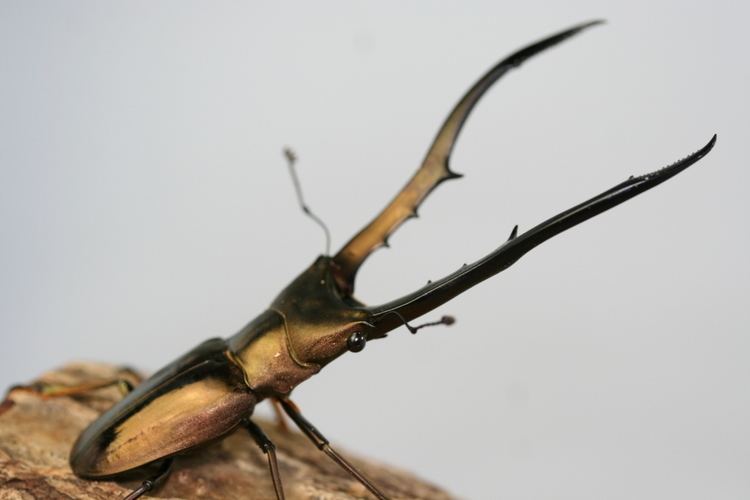 | ||
Similar Stag beetle, Taxonomy of Lucanidae, Insect, Beetle, Cyclommatus elaphus | ||
Animal crossing new leaf cyclommatus stag
Cyclommatus is a genus of the Lucanidae family, also known as the stag beetle. The majority of the species from the genus Cyclommatus are located in Southeast Asia, though some species can be found in China and Taiwan as well. The genus Cyclommatus also consists of three subgenera: Cyclommatus (Parry, 1863), Cyclommatinus (Didier, 1927) and Cyclommatellus (Nagel, 1936). Each subgenera contains 80, 24 and 3 species respectively. In total, the genus Cyclommatus consists of a total of 132 species, though more are still being discovered to this day.
Contents
- Animal crossing new leaf cyclommatus stag
- Hd cyclommatus pulchellus from kingdom of beetle taiwan origin papua new guinea mp4
- Taxonomy
- Evolution
- Distribution
- Description
- Life cycle
- Pet trade
- Species
- References
The chief distinguishing characteristics of this genus are its impressive mandibles, which can sometimes be as long as its body, as well as its lustrous metallic exoskeleton, which can range from red, brown, green, purple, gold and a rarer blue-black. As such, beetles from the genus Cyclommatus can command a high price from collectors, with a demand for both live and dried specimens.
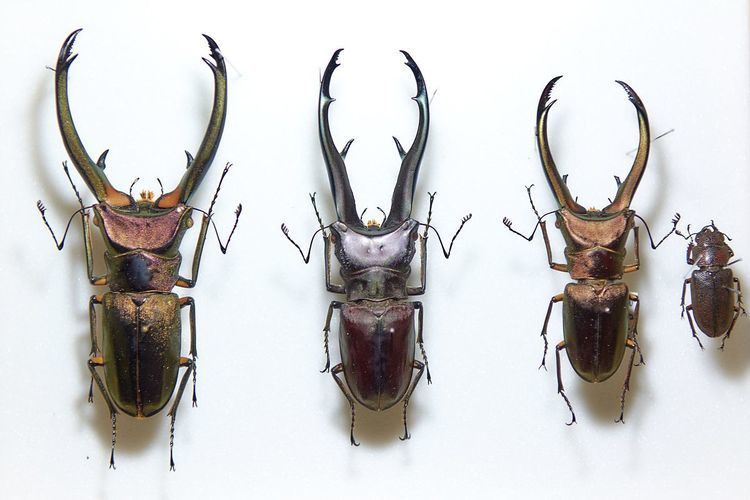
The largest specimens from this genus can grow up to approximately 105 mm (4.1 in) in length measured from the tip of the mandibles to the end of the abdomen.
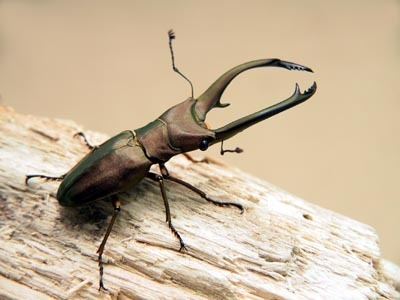
Hd cyclommatus pulchellus from kingdom of beetle taiwan origin papua new guinea mp4
Taxonomy
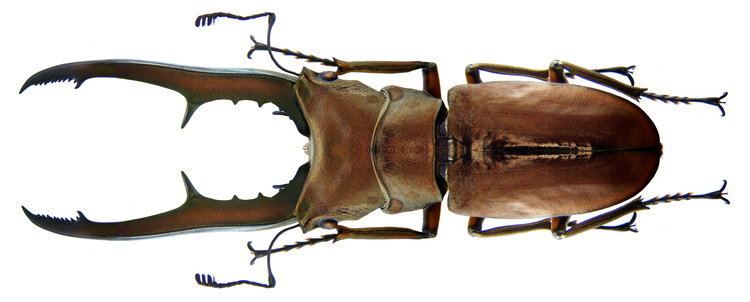
The first beetle from genus Cyclommatus was described by Jean Baptiste Boisduval in 1835 and was initially given the binomial name Lucanus metallifer. Later in 1863, in "A few Remarks upon Mr. James Thomson'S Catalogue of Lucanidæ, published in the 'Annales de la SociéTé Entomologique de France, 1862'," English entomologist Frederic Parry first suggests the name Cyclommmatus as the name of a new genus in the family Lucanidae, and this has been the name of this genus ever since.
Different sources place the genus Cyclommatus under the tribe Cladognathini (Parry, 1870), or Cyclommatini (Maes, 1992).
Evolution
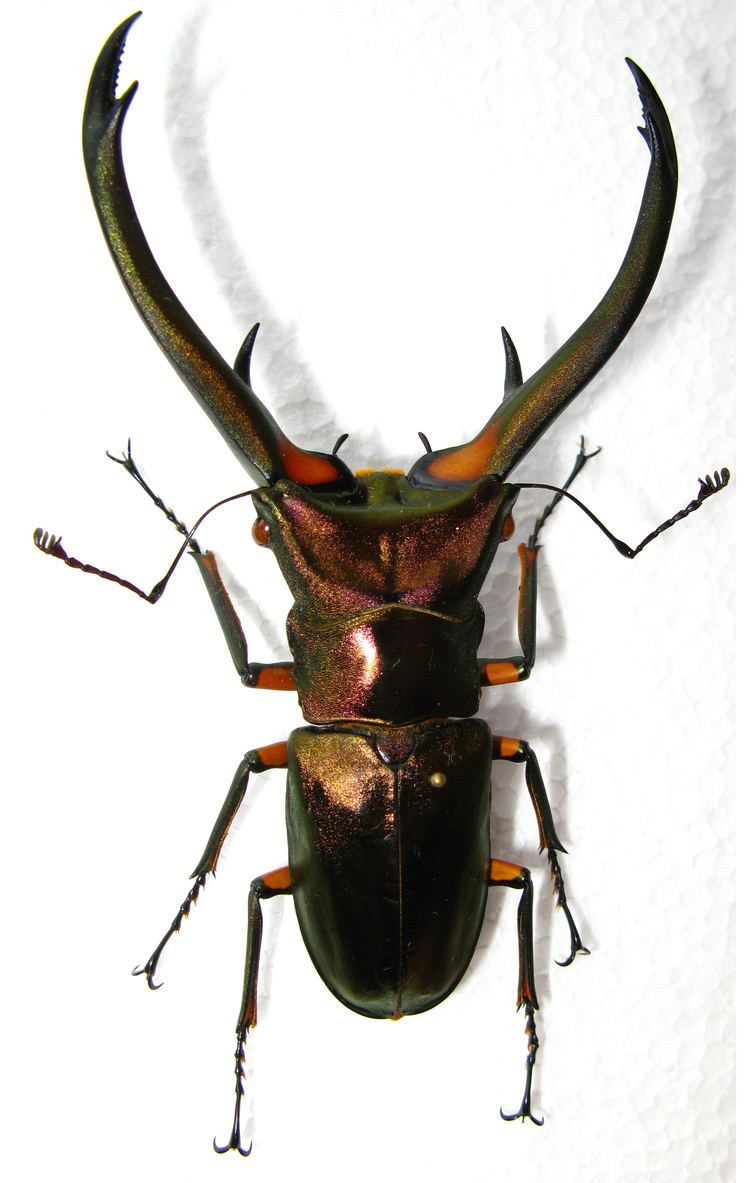
The family Lucanidae is a monophyletic group in which it evolved from an unique ancestor or group of ancestors. Using the BEAST software, which stands for Bayesian Evolutionary Analysis Sampling Trees to model the genetic divergence in Lucanidae, the genus Cyclommatus is thought to have diverged around 50-20 million years ago, with the average being 33.2 million years ago. The temporal range given above is with a 95% highest posterior density (HPD) confidence interval.
Distribution
Cyclommatus can be found in many parts of the world, including:
Afghanistan, Bhutan, China, Iceland, India, Indonesia, Japan, Laos, Malaysia, Myanmar, Nepal, Papua New Guinea, Philippines, Sierra Leone, Singapore, Solomon Islands, Taiwan, Thailand and Vietnam.
Description
Male beetles of genus Cyclommatus are generally larger than females of the same species, and exhibit brighter and lustrous exoskeletons compared to females. Some species of this genus also colour polymorphic and as such exhibit a wide variety of different colours within the same species, which can range from red, brown, green, purple, gold and a rarer blue-black.
Males of a larger size, or major males, relative to their respective species in this genus exhibit enlarged mandibles. These enlarged mandibles are not used for feeding, but rather for competing with other males for mates, and males with larger mandibles are more likely to win these male–male fights.
Due to their smaller mandibles and need to chew through decaying wood to lay eggs, females are thought to have a greater biting force. However, contrary to popular belief, the biting force of the male mandibles can in fact exceed the biting force of the females, for example, the biting force of Cyclommatus metallifer males was found to 3 times that of females.
Life cycle
The life cycle of beetles in genus Cyclommatus share many characteristics of that of other stag beetles, starting with an egg, then three larval stages, pupation and finally eclosion.
After mating, female beetles use their smaller mandibles better adapted to cutting wood to create tunnels within decaying logs in which eggs are laid. The beetle larva once hatched from its egg, experiences three larval stages: instar 1, 2 and 3. The transition between each of the instars requires the larva to moult, as each larva of each successive instar has a larger chitin head. For members of genus Cyclommatus, the larval stage lasts can last a few months to up to one and a half to two years for large individuals. During this time, larva mainly subsist on decaying logs.
Once the larva have received an adequate amount of nutrients, the larva then creates a pupal chamber in which the larva lies in a pre-pupal state with limited mobility, creating its pupa beneath its larval skin. On completing its pupa, the larva then sheds its skin and fills the entirety of the pupa with hemolymph. When the pupa is completely full and the mandibles fully harden, the soft white pupa gradually darkens to brown, and the pupa becomes harder.
As the beetle inside the pupa matures, the pupa darkens and the beetle within becomes more prominent, for example, the eyes of the beetle may be seen. When this occurs, the beetle will usually eclose a few days later.
As adults, beetles of genus Cyclommatus generally subsist on tree sap, and many do not have a lifespan of any longer than one year.
Pet trade
Large specimens of these genus can command high prices upwards due to the lustrous metallic bodies that the beetles possess. Collectors buy both live and dried specimens, with many of the live specimens being exported to countries such as Japan and Taiwan, which has a large market for keeping beetles as exotic pets. Popular beetle species from this genus include: Cyclommatus elaphus, Cyclommatus metallifer and Cyclommatus imperator.
When kept in captivity, beetles of this genus can consume mangos, bananas and a variety of fruits in addition to purpose beetle jellies as adults, whilst beetle breeders in Japan have experimented with many foods for the larva, such as fermented wood, decaying logs and sawdust inoculated with mycelium. This is done in order to maximise the growth during the larval period, as all growth occurs during the larval period and thus the adult size is dependent on the availability of nutrients to the larva.
The most suitable type of food for beetle larva of this genus differs between species, but beetle larva of this genus generally subsist on wood based foods, much like other beetle larva of family Lucanidae.
Species
The genus Cyclommatus comprises:
